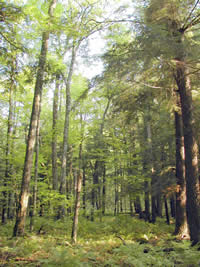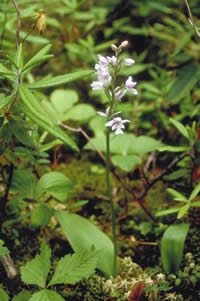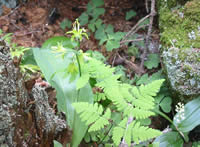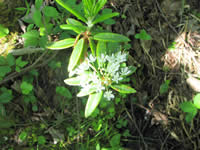Eastern Region Viewing Area
LOCATION and PHOTOS
 A typical early summer/late spring view in Argonne. There are conifers on the right and hardwoods on the left. Photo by Steve Janke.
A typical early summer/late spring view in Argonne. There are conifers on the right and hardwoods on the left. Photo by Steve Janke.
 Small round-leaved orchid (Amerorchis rotundifolia) is a spring orchid occurring in wetlands and bogs. Notice the spotted "tongue". Photo by David Schmoller.
Small round-leaved orchid (Amerorchis rotundifolia) is a spring orchid occurring in wetlands and bogs. Notice the spotted "tongue". Photo by David Schmoller.
 Blue-bead lily (Clintonia borealis) occurs in the understory of hardwood forests. Its fruits are dark blue and round, hence its common name. Photo by Chantelle DeLay.
Blue-bead lily (Clintonia borealis) occurs in the understory of hardwood forests. Its fruits are dark blue and round, hence its common name. Photo by Chantelle DeLay.
 Labrador tea (Ledum groenlandicum) is a small shrub occurring in bogs and wetlands. The underside of the leaf has a rust-colored "wool". Photo by Chantelle DeLay.
Labrador tea (Ledum groenlandicum) is a small shrub occurring in bogs and wetlands. The underside of the leaf has a rust-colored "wool". Photo by Chantelle DeLay.
Argonne Experimental Forest
Forest: Chequamegon-Nicolet National Forest
District: Eagle River-Florence District – Eagle River Unit
Description: Argonne Experimental Forest features the largest contiguous tract of old-growth hemlock hardwood forest on drumlinized ground moraine. These types of protected rich mesic hardwood forests are very scarce in northern Wisconsin and on this land type (Argonne Outwash Plains). A northern hardwood forest dominated by sugar maple, hemlock, yellow birch, and basswood is located on a gently sloping, unpitted outwash fan. Shrubs include leatherwood and elderberry. Understory plants include oak fern, ground pine, wood ferns, rosy twisted stalk, Canada mayflower, running club-moss, lady fern, and sweet cicely. This area is surrounded by a conifer swamp, which has several rare species. The conifer swamp is dominated by black spruce, tamarack, and white cedar. Understory species include Labrador tea, leather-leaf, balsam fir, yellow bluebead lily, false mayflower, creeping snowberry, Canada blueberry, and sphagnum. Rare species include small round-leaved orchis, sparse-flowered sedge, and northern bog sedge. The extensive habitat of Argonne Experimental Forest supports uncommon boreal bird species such as boreal chickadee and gray jay. In addition, the rare three-toed woodpecker (Picoides tridactylus) has been seen in the conifer swamp. Other birds include broad-winged hawk, blackburnian warbler, and scarlet tanager.
Viewing Information: Early spring ephemeral wildflowers are the focal attraction. Come in the first 3 weeks of May before the trees leaf-out for the best show. The silty soil supports carpets of spring beauty, Dutchman’s breeches, squirrel corn, false rue anemone, large-flowered and nodding trillium, toothwort, bloodroot, wild leek, blue cohosh, maidenhair fern, sessile bellwort, and woods nettle. Starting in mid-June, the conifer swamps put on a show of bog plants, including orchids and Labrador tea.
Safety First: There is one designated trail here and off-trail hiking is permitted. Clambering over the moss-covered rocks and wet roots and vegetation can be treacherous, so wear boots with ankle support. Spring weather is cool and sometimes rainy, so dress appropriately. There may be no cellular telephone service here due to the remoteness. Sounds daunting, but the wildflower show is worth it!
Directions: From Hiles, Wisconsin, go northwest on Highway 32 1.7 miles, then north on FR 2184 about 2.6 miles. A portion of this site lies between FR 2184 and FR 3903. The northern portion can be accessed by continuing north on FR 2184, then east on FR 2183 1.4 miles. The site lies north and south of the road.
From Eagle River, Wisconsin, go east on Highway 70 to Highway 45 south. Travel about 9 miles and turn left on Highway 32. Drive for another 6 miles and then turn left again on FR 2183, also called Scott Lake Road (just past FR 2178). Travel about 7 miles or until you see Argonne Experimental Forest signs. Turn right onto FR 2184, which leads into the experimental forest and to a trailhead.
Ownership and Management: U.S. Forest Service, Chequamegon-Nicolet National Forest, Eagle River-Florence District.
Closest Town: Hiles, Wisconsin.

